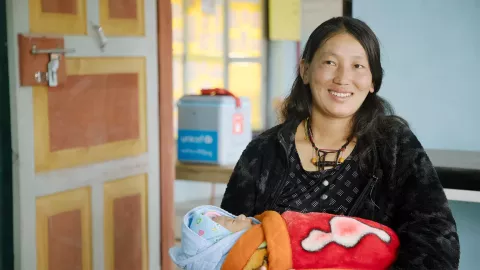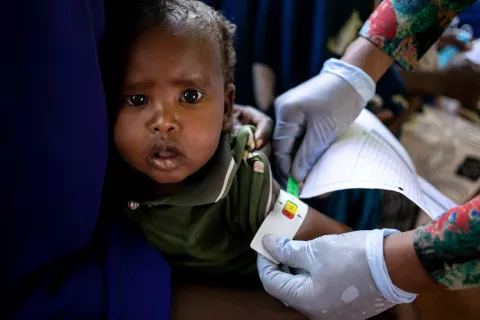1 in 4 health care facilities lacks basic water services – UNICEF, WHO

GENEVA/NEW YORK 03 April 2019– One in four health care facilities around the world lacks basic water services, impacting over 2 billion people, according to a new report by the World Health Organization (WHO) and UNICEF Joint Monitoring Programme for Water Supply, Sanitation and Hygiene (JMP).
The WHO/UNICEF JMP report, WASH in Health Care Facilities, is the first comprehensive global assessment of water, sanitation and hygiene (WASH) in health care facilities. It also finds that 1 in 5 health care facilities has no sanitation service*, impacting 1.5 billion people. The report further reveals that many health centres lack basic facilities for hand hygiene and safe segregation and disposal of health care waste.
These services are crucial to preventing infections, reducing the spread of antimicrobial resistance and providing quality care, particularly for safe childbirth.
“Water, sanitation and hygiene services in health facilities are the most basic requirements of infection prevention and control, and of quality care. They are fundamental to respecting the dignity and human rights of every person who seeks health care and of health workers themselves,” said António Guterres, United Nations Secretary-General. “I call on people everywhere to support action for WASH in all health care facilities. This is essential to achieve the Sustainable Development Goals.”
The WHO/UNICEF JMP report found that just half – 55 per cent – of health care facilities in Least Developed Countries (LDCs) had basic water services. It is estimated that 1 in 5 births globally takes place in LDCs, and that, each year, 17 million women in these countries give birth in health centres with inadequate water, sanitation and hygiene.
“When a baby is born in a health facility without adequate water, sanitation and hygiene, the risk of infection and death for both the mother and the baby is high,” said UNICEF Executive Director Henrietta Fore. “Every birth should be supported by a safe pair of hands, washed with soap and water, using sterile equipment, in a clean environment.”
In an accompanying report, Water, sanitation, and hygiene in health care facilities: Practical steps to achieve universal access for quality care, WHO and UNICEF researchers note that more than 1 million deaths each year are associated with unclean births. Infections account for 26% of neonatal deaths and 11% of maternal mortality.
“Imagine giving birth or taking your sick child to a health centre with no safe water, toilets or handwashing facilities,” said Dr Tedros Adhanom Ghebreyesus, WHO Director-General. “That’s the reality for millions of people every day. No one should have to do that, and no health worker should have to provide care in those circumstances. Ensuring that all health care facilities have basic water, sanitation and hygiene services is essential for achieving a healthier, safer, fairer world.”
At the 2019 World Health Assembly to be held in May, governments will debate a resolution on Water, Sanitation and Hygiene in Health Care Facilities which was unanimously approved by the WHO Executive Board earlier this year.
The WHO and UNICEF Practical Steps report provides details on eight actions governments can take to improve the WASH services in health care facilities including establishing national plans and targets, improving infrastructure and maintenance and engaging communities. These actions and resulting improvements in WASH services can yield dramatic returns on investment in the form of improved maternal and newborn health, preventing antimicrobial resistance, stopping disease outbreaks and improving quality of care.
According to UNICEF, 7,000 newborn babies died every day in 2017, mostly from preventable and treatable conditions including infections like sepsis. As part of its Every Child Alive Campaign, UNICEF is calling for governments and authorities to make sure every mother and baby have access to affordable, quality care.
Last year, Fore and Dr Tedros called on countries to strengthen their primary health care systems as an essential step toward achieving universal health coverage.
******************************************
Note to editors
To download broll and photos, click here.
Links to download the reports:
- WHO/UNICEF JMP report, WASH in Health Care Facilities
- WHO and UNICEF report, Water, sanitation, and hygiene in health care facilities: Practical steps to achieve universal access for quality care
Both reports can be downloaded from www.washdata.org.
*No sanitation service means that health care facilities had unimproved toilets, or no toilets at all.
The data provide a robust basis for identifying priorities, making investments and tracking progress, which is particularly important as global momentum to address the issue is growing. In addition, the WHO-led Global Analysis on Sanitation and Drinking-Water (GLAAS) will release new figures from over 100 countries later this year, and includes a strengthened module on WASH in health care facilities policies and investments. This will provide another mechanism to track commitments and progress.
| Basic Water Services | Water that is available from an improved source that is located at the health facility | Basic Water | |
| Basic sanitation services |
|
Basic toilets | |
| Basic hygiene services | Functional hand hygiene facilities (with water and soap and/or alcohol-based hand rub) are available at points of care, and within 5 meters of toilets. |
|
|
| Basic health care waste management service | Waste is safely segregated into at least three bins and sharps and infectious waste are treated and disposed of safely | Basic waste management | |
| Basic environmental cleaning service | Basic protocols for cleaning are available, and staff with cleaning responsibilities have all received training. | Basic cleaning |
Sustainable Development Goal 6 is to ensure availability and sustainable management of water and sanitation for all.
- 6.1 By 2030, achieve universal and equitable access to safe water and sanitation for all.
- 6.2 By 2030, achieve access to adequate and equitable sanitation and hygiene for all and end open defecation, paying special attention to the needs of women and girls and those in vulnerable situations.
Safe water, sanitation and hygiene are also essential to SDG 3 “Ensuring healthy lives and promote wellbeing for all at all ages”. Under SDG target 3.9, countries are working to substantially reduce the number of deaths and illnesses from hazardous chemicals and air, water and soil pollution and contamination by 2030. Additionally, safe water, sanitation and hygiene are needed to reduce maternal mortality and to end preventable deaths of newborns and children as called for in SDG targets 3.1 and 3.2 and WASH services in health care facilities are fundamental to achieving universal health coverage (target 3.8).
About the JMP
The WHO/UNICEF Joint Monitoring Programme (JMP) for Water Supply, Sanitation and Hygiene is responsible for monitoring global progress towards the Sustainable Development Goal (SDG) targets and indicators relating drinking water, sanitation and hygiene (WASH). The JMP produces national, regional and global estimates of progress on WASH in households, schools and health care facilities.
About WHO
The World Health Organization provides global leadership in public health within the United Nations system. Founded in 1948, WHO works with 194 Member States, across six regions and from more than 150 offices, to promote health, keep the world safe and serve the vulnerable. Our goal for 2019-2023 is to ensure that a billion more people have universal health coverage, to protect a billion more people from health emergencies, and provide a further billion people with better health and wellbeing.
Visit our website www.who.int
Follow WHO on Facebook; Twitter; YouTube; Instagram


